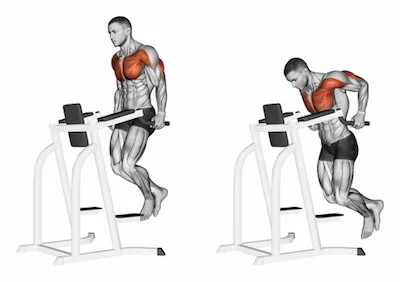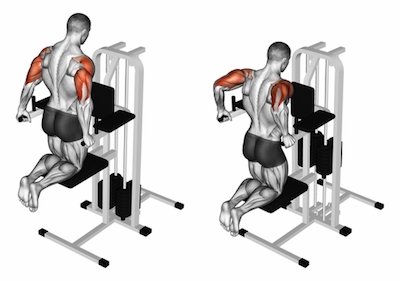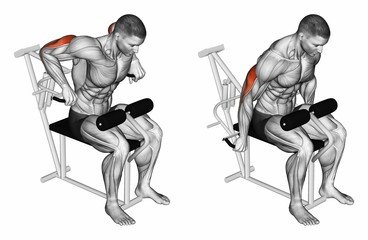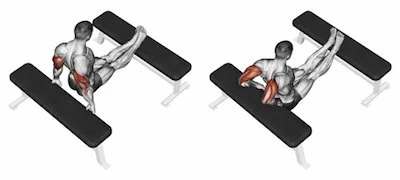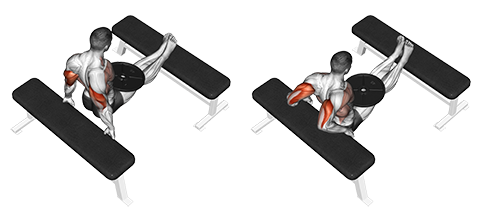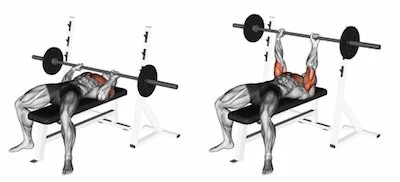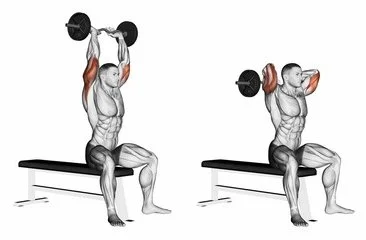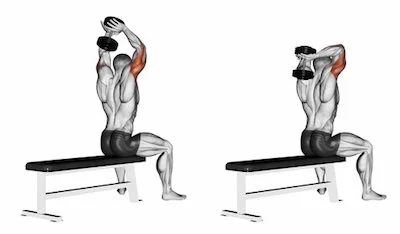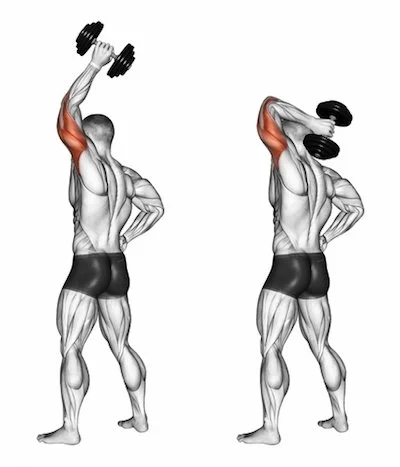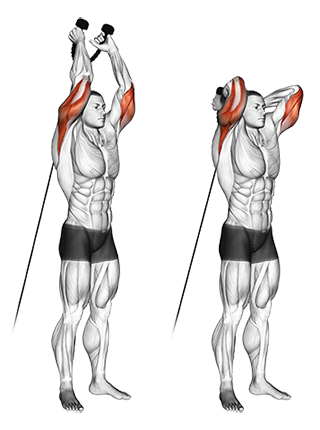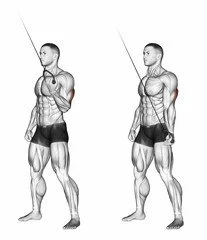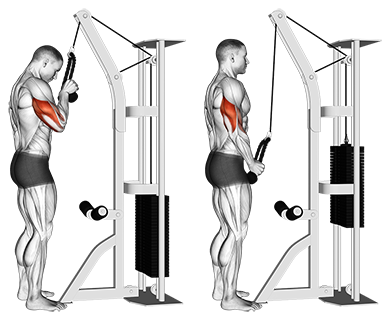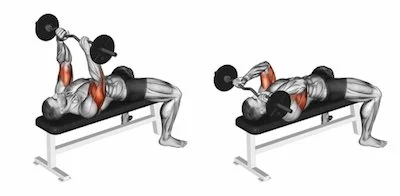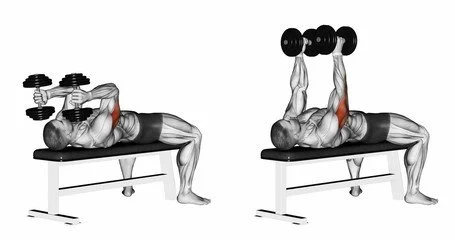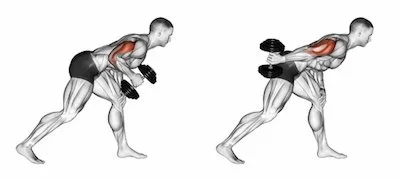Triceps Dips
Take position in the parallel bars, your arms at full extension to keep your body upright and straight. Your core is tight and your legs may either hang down or be bent at the knee to allow you more dip depth without touching the floor. This is the starting position.
Commence the movement by bending at the elbow such that your body lowers. Your torso remains straight and your elbows close by the body. Inhale through the movement.
When the elbow reaches a 90 degree angle, reverse the movement by pushing up through the triceps and back to the starting position, exhaling as you do.
Assisted Triceps Dips
Pin a suitable weight to support your body without removing all difficulty from the lift.
Take position in the parallel bars, pop one knee at a time up onto the support pad. Take your arms to full extension so to keep your body upright and straight. Your core is tight and your legs are bent at the knee in a 90 degree angle on top of the pad. This is the starting position.
Commence the movement by bending at the elbow such that your body lowers. Your torso remains straight and your elbows close by the body. Inhale through the movement.
When the elbow reaches a 90 degree angle, reverse the movement by pushing up through the triceps and back to the starting position, exhaling as you do.
Dismount by taking one knee off the support pad then placing that foot on the ground. Keeping your hands on the parallel bars, use your other knee and body weight to slowly let the support pad come back to its resting position. You can then bring the other knee off.
Triceps Dips Machine
Take a seated position on the dip machine locking your legs under the knee rolls and placing your feet flat on the floor. Your core is tight and your hands are placed palms down on the machine handles with elbows pointing back rather than flaring sideways. This is the starting position.
Commence the movement by pushing the weight through the triceps and extending the arm so that the elbow joint opens up and the machine handles push down. Exhale through the movement.
When the arm is almost fully extended and the triceps is at maximum contraction, reverse the movement back to the starting position, inhaling as you do.
Bench Triceps Dips
Setup two benches (or any support platform) with enough distance between them to support you in the outstretched dip position. Position yourself facing away from one bench and toward the other. Grab hold of the edge of the back bench just outside of shoulder-width and pop your outstretched legs up onto the front bench. They should be extended straight and only in contact with the front bench from ankle down. Your core is tight and your back straight. This is the starting position.
Commence the movement by bending at the elbows such that your body lowers. Your torso remains straight and your elbows are bending backwards behind the body and tight to it, not flaring wide. Inhale through the movement.
When the elbow reaches a 90 degree angle, reverse the movement by pushing up through the triceps and back to the starting position, exhaling as you do.
Close Grip Barbell Bench Press
Take position on a flat bench with your feet flat on the floor. Grip the barbell in a narrow, shoulder-width grip and arch your back slightly. Un-rack the bar so that you are at full arm extension above your chest and settle yourself.
From this starting position, lower the bar over 1-2 seconds as you breathe in. Unlike a traditional barbell chest press, in the close grip press, the elbows should remain close by the body to maximise the focus on the triceps. The bar should just touch your chest around nipple line at the bottom of the movement but without bouncing off the chest.
Raise the bar over 1-2 seconds as you breathe out, squeezing the triceps and returning to the starting position.
Seated Overhead Barbell Triceps Extensions
Grab hold of a suitable weight barbell or EZ bar and take a seated position at the end of a flat bench. Keep your core tight, your torso straight and place your feet flat on the floor. Take an overhand, shoulder width-grip on the bar and raise it above your head such that the arms are fully extended and the palms now face up and forward. This is the starting position.
Commence the movement by bending at the elbows to lower the bar behind the neck. The elbow acts as a hinge joint - the upper arms should remain stationary and the movement comes only from the forearms. You should feel a large stretch through the triceps. Inhale through the movement.
When the elbows have reach their maximum range of motion, reverse the movement by pushing up through the triceps and extending the arms back to the starting position, exhaling as you do.
Seated Two Arm Overhead Dumbbell Triceps Extensions
Grab hold of a suitable weight dumbbell and take a seated position at the end of a flat bench. Keep your core tight, your torso straight and place your feet flat on the floor. Now use both hands to pick up the dumbbell in a palms-up grip that locks the fingers around the inside of one end of the dumbbell.
Raise the dumbbell above your head such that the arms are fully extended and the weight of the dumbbells sits in the palms. This is the starting position.
Commence the movement by bending at the elbows to lower the dumbbell behind the neck. The elbow acts as a hinge joint - the upper arms should remain stationary and the movement comes only from the forearms. You should feel a large stretch through the triceps. Inhale through the movement.
When the elbows have reach their maximum range of motion, reverse the movement by pushing up through the triceps and extending the arms back to the starting position, exhaling as you do.
Standing One Arm Overhead Dumbbell Triceps Extensions
Grab hold of a suitable weight dumbbell and keeping your core tight, your torso straight and feet at shoulder-width, raise it above your head. The arm should be fully extended and your palm is facing forward. This is the starting position.
Commence the movement by bending at the elbow to lower the dumbbell behind the neck. The elbow acts as a hinge joint - the upper arms should remain stationary and the movement comes only from the forearms. You should feel a large stretch through the triceps. Inhale through the movement.
When the elbow have reached its maximum range of motion, reverse the movement by pushing up through the triceps and extending the arms back to the starting position, exhaling as you do.
Reverse Grip One Arm Cable Triceps Pushdowns
Pin the pulley height to its highest setting, pin a suitable weight and position yourself adjacent to the stack.
Take hold of the cable handle with the hand that is closest to the stack, palms facing upward. You should be facing in towards the stack so that the cable handle moves down and toward your legs when you perform the movement. Your core is tight and your feet are flat on the floor at shoulder-width. Your elbow is locked to your side and when you take the weight, your forearm will be angled up toward the cable pulley. This is the starting position.
Commence the movement by squeezing the triceps and extending your arm in a large arc from the chest around to the groin. The elbow acts as a hinge joint - the upper arms should remain stationary, elbow pinned to the side and the movement comes only from the forearm. You should feel a large contraction through the triceps. Exhale through the movement.
When the arm is fully extended and the handle approaches your groin, reverse the movement by returning the arm back to the starting position without lifting your elbow, inhaling as you do.
Lying Barbell Triceps Extensions
Grab hold of a suitable weight barbell or EZ bar and take a seated position at the end of a flat bench. Take an overhand, shoulder-width grip on the bar then slowly lower your torso back until it is flat on the bench. Keep your core tight and your feet flat on the floor, press the bar directly up so that your arms are fully extended and the palms now face up and forward. This is the starting position.
Commence the movement by bending at the elbows to lower the bar toward your forehead. The elbow acts as a hinge joint - the upper arms should remain stationary and the movement comes only from the forearms. You should feel a large stretch through the triceps. Inhale through the movement.
When the elbows have reach their maximum range of motion and before the bar hits your forehead, reverse the movement by pushing up through the triceps and extending the arms back to the starting position, exhaling as you do.
Lying Dumbbell Triceps Extensions
Grab hold of suitable weight dumbbells and take a seated position at the end of a flat bench. With dumbbells upright on the thigh muscle just above your knee cap and palms facing each other, slowly lower your torso back until it is flat on the bench. Keep your core tight and your feet flat on the floor, press the dumbbells directly up so that your arms are fully extended above your chest and the palms face inward. This is the starting position.
Commence the movement by bending at the elbows to lower the dumbbells toward your ears. The elbow acts as a hinge joint - the upper arms should remain stationary and the movement comes only from the forearms. You should feel a large stretch through the triceps. Inhale through the movement.
When the elbows have reach their maximum range of motion and before the dumbbells hit your side head, reverse the movement by pushing up through the triceps and extending the arms back to the starting position, exhaling as you do.
One Arm Triceps Kick-Backs
Grab hold of a suitable weight dumbbell and take position in a split stance. The leg on the same side as your lifting arm is back; the leg on the same side as your non-lifting arm is forward and you are placing the body weight on the front thigh. Setting the forearm on that thigh can help with balance. Your torso is at a 45 degree angle to the floor and you are bent only from the waist, not arching your back.
Hold the dumbbell in your lifting arm with a palm facing inward grip. That arm is at a 90 degree angle with the hinge point, the elbow, being pinned to your side. This is the starting position.
Commence the movement by extending at the elbows to kick the dumbbell backward. The upper arm should remain stationary and the movement comes only from the forearms. You should feel a the contraction through the triceps. Exhale through the movement.
When the arm is fully extended behind you, elbow remaining pinned to your side, reverse the movement by returning the arm back to the starting position without lifting your elbow, inhaling as you do.

